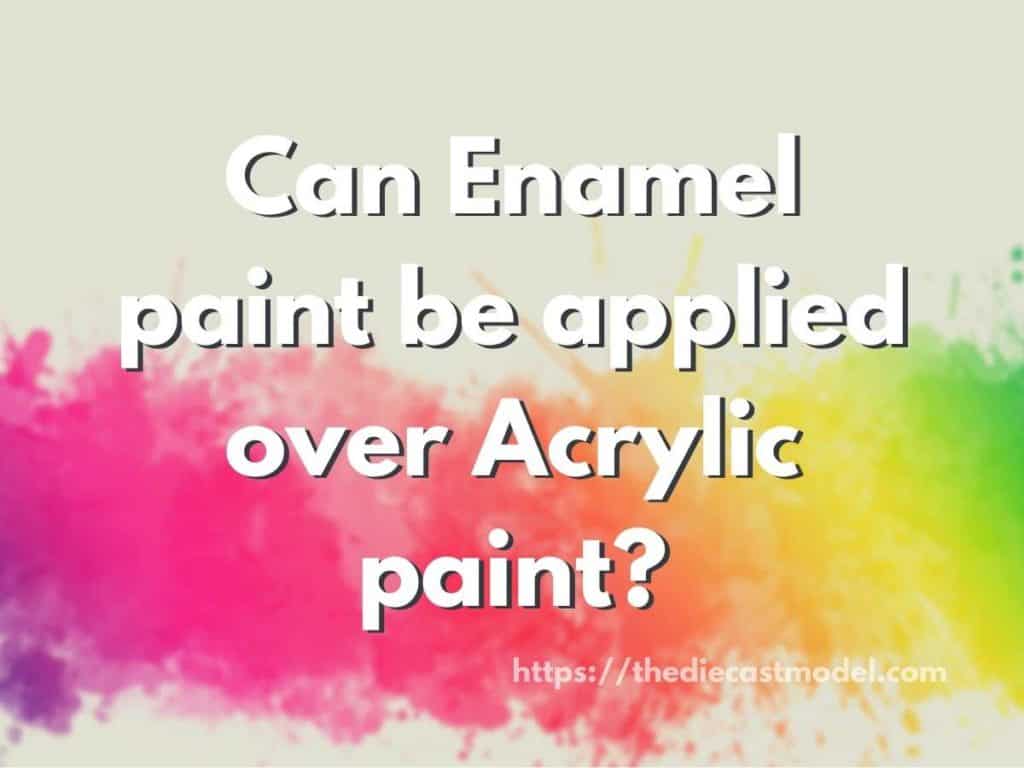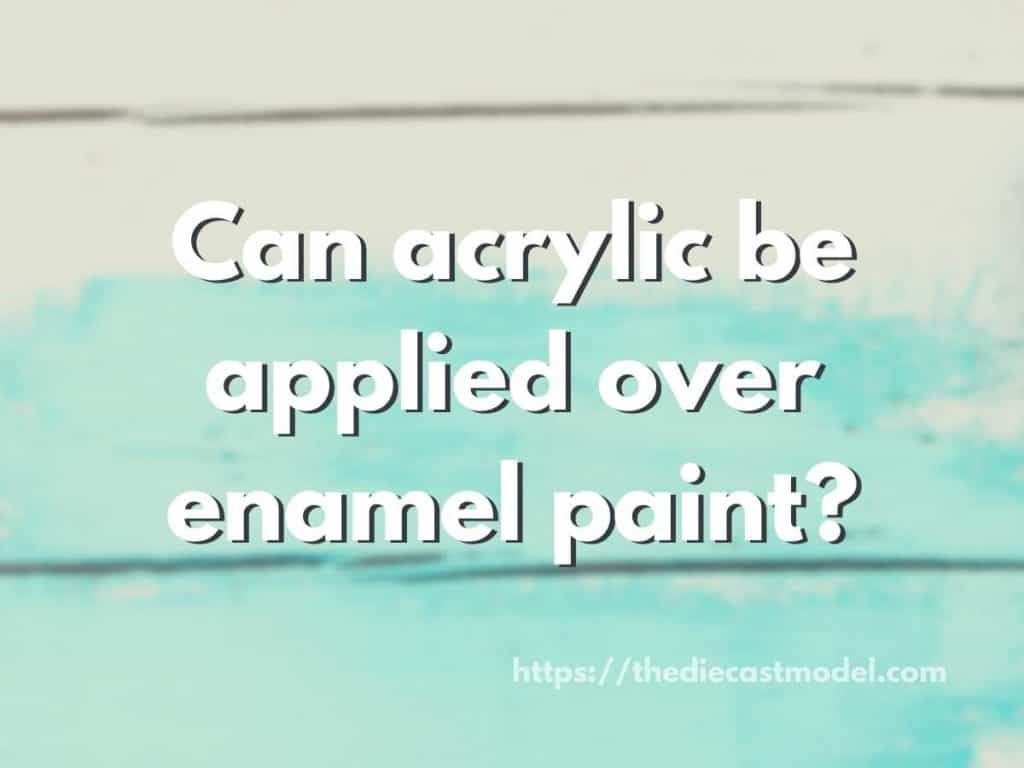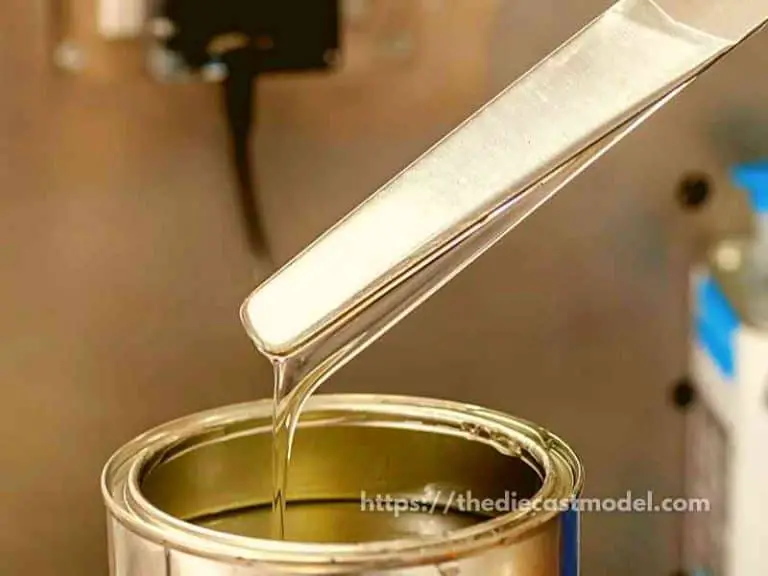Can Enamel be applied over Acrylic paint and Vice Versa? How to use Both Paints
What are some tricks for painting over acrylic or enamel? Of course, you can apply both enamel and acrylic paint on top of other paints. However, there are some things to keep in mind when doing so. This blog post will talk about what to take note of when trying to put paint over another.
You can put enamel paint over acrylic and acrylic paint over enamel, provided that you do some precautions, such as applying a primer and sanding. Furthermore, it is advisable to only put paint over the other if the other paint has completely dried or cured.
Here, we will talk about the things we need to make sure of when applying paint over another, such as topcoats, primer, sanding, paint composition, and more. This way, you will be armed with knowledge on what to do for your next painting job.

Can enamel be applied over acrylic?
Enamel can be applied over acrylic paints, provided that the acrylic paint is completely dried and doesn’t have any topcoats. Since acrylic and enamel paint can’t mix with each other, applying enamel over acrylic while still wet can cause it to fall off or form bubbles.
Furthermore, topcoats are designed to protect the inside paint from outside stress such as water, oxidation, and other chemicals.
That’s why if a clear coat is already applied to acrylic paint, it is not a good idea to cover it with enamel paint.
Applying enamel paint over acrylic paint can cause enamel to fall off because of the clear coat.
The easiest way to know if acrylic paint is covered with a topcoat is to put a drop of water. Since the clear coat’s job is to protect the paint from the environment, such as water, acrylic paint covered with a clear coat will repel water.
You can see this repel action if the water slides in the surface if you are checking while the surface is vertical or if the water clumped into circles if tested horizontally.
Here is a photo example of what I’m talking about. If the water becomes like this, the paint has been covered with a topcoat.

A more straightforward test to check if acrylic paint is covered with a clear coat is to check its glossiness.
Generally speaking, acrylic paint produces matte colors. That’s why many painters apply a top coat to add some gloss to the finished product.
Thus, if the paint looks glossy, there is a high chance that the acrylic paint is covered with a topcoat.
However, this test is not as accurate as the first test I talked about.
Another thing to note when putting enamel over acrylic is if the paint is fully cured or dried.
Ensure that the paint or the surface is completely dried off when applying enamel paint.
This is because enamel paint is oil-soluble and not water-soluble.
Any excess water molecules could be trapped inside the paint and can cause the enamel paint to form bubbles or chip off after some time.
Thus, avoid painting over acrylic paint if the paint is still wet.
Now that you know how to apply enamel over acrylic paint, how about using acrylic over enamel paint? Are there things to look out for? Let’s find out.

Can acrylic be applied over enamel paint?
Acrylic paint can be applied over enamel paint provided that the surface of the paint has been prepared such as removing oils on the surface. Furthermore, lacquer thinner-based enamel paints can interfere with acrylic paint so make sure that the paint used is mineral oil-based.
Applying acrylic over enamel paint is more complicated than enamel over acrylic.
For one, since enamel paint is oil-based, it can cause acrylic paints to slide off the surface. That’s why some painters prefer to remove the enamel paint either by scraping, thinning, or sanding.
Remember that acrylic paints are water-based. This means it doesn’t mix well with oil.
Furthermore, make sure that the surface is prepared if you want to paint with acrylic.
Compared to enamel, acrylic paints are prone to paintbrushes and irregularities on the surface. Thus, sanding or making the surface smooth is a good idea before painting.
Another way to make sure that the acrylic paint stick is to apply a primer.
Primers bind to both the paint and the surface. So, applying a primer makes sure that the acrylic paint sticks to the surface.
This is the best and easiest way to make sure the paint lasts longer.
Lastly, check the thinner. Basically, since enamel paints are oil-soluble, it uses either mineral oil or lacquer as their thinner.
Make sure that the enamel paint uses mineral spirits as it’s thinner. Also, lacquer is known to melt acrylic paints. Thus, using lacquer-based paint can interfere with the painting job.
Now that you know and understand how to use both paints let’s combine everything we now understand and answer if you can use both acrylic and enamel paint on the same painting job.
Can you use acrylic and enamel on the same model?
You can use both acrylic and enamel paint on the same model. However, you should not mix both paints before painting and taking note that enamel paint dries longer than acrylic paint. Lastly, make sure to apply a clear coat to protect the paint.
There are many reasons why a painter or a modeler would want to use both paints.
The most common reason is that the painter only has acrylic paint or enamel paint of that color.
Another reason is variety. Since acrylic paints tend to have a wider variety of colors, many people would opt for using one.
However, while you can use both in the same build, make sure to know the following.
You need to understand that the drying time for enamel and acrylic paint is different.
Generally, acrylic paint dries in about 4 hours, while enamel paint takes a day to dry thoroughly.
Thus, make sure to wait for the enamel paint to dry before touching the model.
Furthermore, take note that while enamel paint doesn’t require primers, acrylic paint does.
Thus, it is good practice to apply a primer to make sure the acrylic paint lasts longer.
Lastly, understand that acrylic paint gives a matte finish while enamel paints provide a glossy finish.
Thus, if the results look pretty weird after the paint has dried, you can apply a clear coat to even the gloss.
With these, you can use both paints on your build. However, that doesn’t mean you can mix both paints.
What’s next? Now that you understand how to use both paints and apply one over the other, how about mixing an enamel and acrylic paint? I talked about this topic in another blog post which you can find here. Can you mix enamel and acrylic paints?






